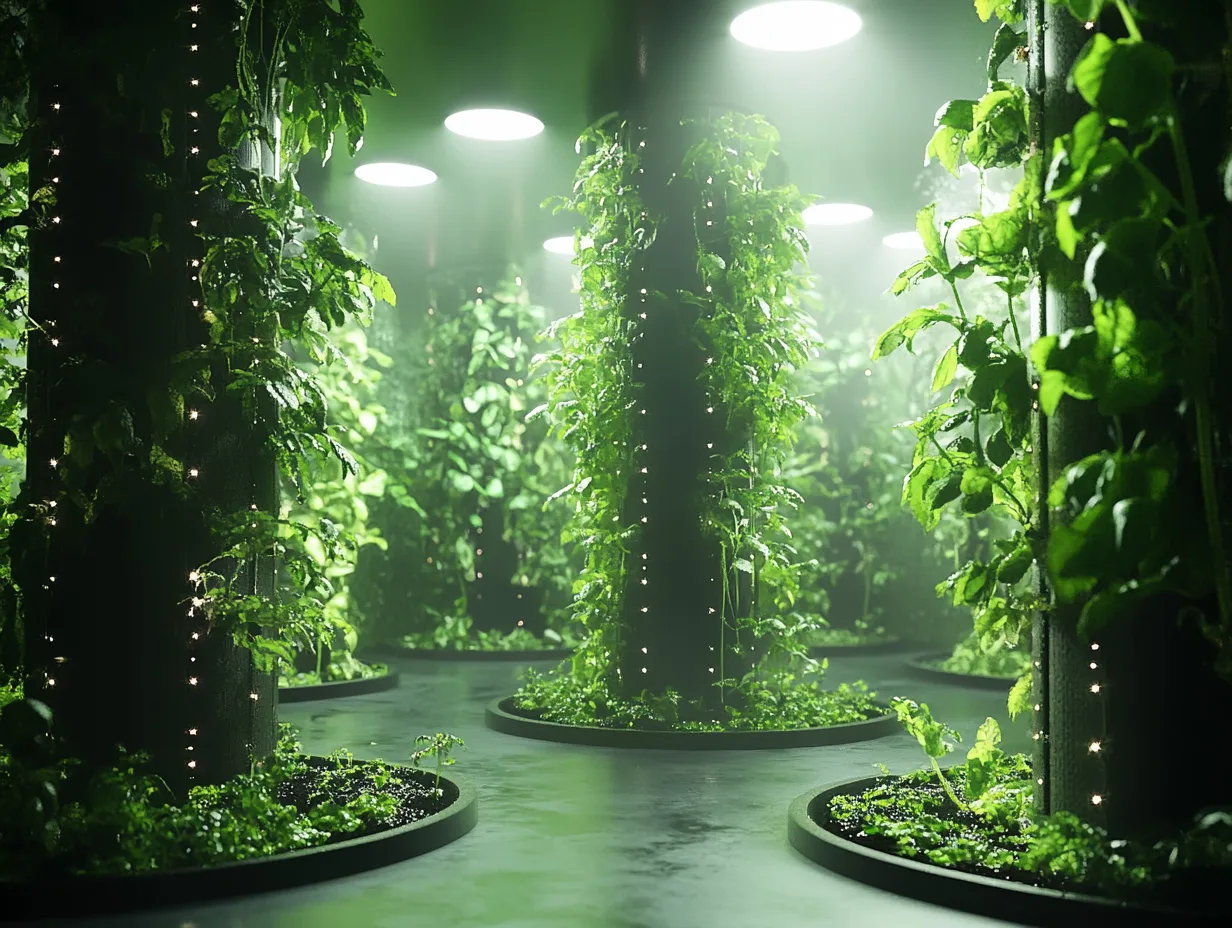How to Grow Vegetables Without Soil
Aeroponic Gardening is a modern way to grow vegetables without soil. In this system, plant roots hang freely in the air. A nutrient-rich mist feeds the roots. This method offers rapid growth and better resource use. It is ideal for urban and indoor spaces. This guide explains aeroponics in detail and shows you how to build and maintain your own system. Learn more advanced tips in The Year-Round Vegetable Garden for Beginners.
In the following sections, you will learn what aeroponic gardening is, its benefits, the equipment you need, the step-by-step setup process, troubleshooting tips, and future trends in this innovative method.
What is Aeroponic Gardening?
Aeroponic Gardening is a type of hydroponics. It does not use any soil. Plants grow with their roots exposed in an air environment. A fine mist supplies nutrients to the roots. This mist contains water and essential nutrients. The roots absorb oxygen very well. This method creates a clean and efficient growing space.
NASA first studied aeroponics for space missions. They wanted to grow fresh food in space. Today, gardeners use this method for many benefits. Aeroponics works well in limited spaces and reduces water use.
For more on efficient gardening methods, check out Efficient Watering Techniques for Sustainable Vegetable Gardening.
Key Benefits of Aeroponic Gardening
Aeroponic systems provide many benefits. They save water. They also increase plant growth speed. The system is space efficient. It reduces the need for chemicals. Here are some major advantages:
- Water Conservation: Aeroponic systems use up to 90% less water than traditional methods.
- Faster Growth: Plants grow more quickly. This is due to high oxygen levels at the roots.
- Cleaner Environment: There is no soil to manage. This lowers the risk of soil-borne diseases.
- Space Efficiency: The system works well in small urban spaces.
- Reduced Maintenance: There is less weeding and fewer pests to handle.
- Scalability: Systems can be built for home gardens or commercial farms.
These benefits make aeroponics attractive for many gardeners who want to maximize yield and reduce resource use.
Essential Equipment for Your Aeroponic System
You will need some specialized equipment to build your aeroponic garden. Below is a list of the basic tools and components:
- Reservoir: A container to hold the nutrient solution.
- Pump and Timer: A pump circulates the nutrient mist. A timer controls the misting intervals.
- Misting Nozzles: These convert the nutrient solution into a fine mist.
- Growing Chamber: This is where plants are suspended. You can use a commercial chamber or build one yourself.
- Net Pots: These secure the plants so that the roots hang in the air.
- Lighting: If you grow indoors, you need full-spectrum LED grow lights.
- pH Meter and Testing Kit: These help you monitor the nutrient solution’s quality.
- Tubing and Connectors: To connect the pump and misting system.
- Support Structure: To hold the growing chamber in place.
For beginners, our guide Vegetable Gardening for Beginners offers helpful starting tips.
Step-by-Step Setup of an Aeroponic System
Building an aeroponic system can seem complex. Follow these simple steps to get started.
Step 1: Plan Your Layout
Plan the space where you will install your system. Decide if you want a vertical tower or a horizontal panel design. Choose a design that fits your space and budget. Sketch your layout on paper.
Step 2: Assemble the Equipment
Place the reservoir in a cool, shaded area. Install the pump and connect it to the timer. Attach the tubing and misting nozzles. Ensure the mist covers the entire root zone. Secure the growing chamber. Insert the net pots into the chamber.
Step 3: Prepare the Nutrient Solution
Follow the nutrient manufacturer’s instructions. Mix the solution in the reservoir. Adjust the pH to the ideal range for your plants. Use the pH meter to verify the level. Run the pump briefly to test the misting system. Make sure the mist is fine and evenly distributed.
Step 4: Start Your Plants
Begin by germinating seeds in a separate tray. Use a light growing medium for the seedlings. Once the seedlings are strong, transplant them into the net pots. Ensure the roots are hanging freely. Place the net pots into the growing chamber.
Step 5: Fine-Tune the System
Set the timer to mist regularly. Misting intervals may range from 5 to 15 minutes depending on your system and plant needs. Monitor the nutrient solution. Top it up as needed. Clean the reservoir and nozzles regularly to prevent clogs.
This step-by-step process will help you build a robust aeroponic system that can produce high yields.
Maintaining Your Aeroponic Garden
Maintenance is key for success. Regular checks help you keep the system running smoothly.
- Monitor Nutrient Levels: Test the solution every few days. Adjust the mix as needed.
- Clean Equipment: Clean the reservoir, tubing, and nozzles every week. This prevents algae buildup and mineral deposits.
- Inspect Plants: Check the roots and foliage daily. Look for signs of stress or disease.
- Adjust Light and Temperature: Ensure the grow lights are at the correct height. Maintain a stable temperature of 65°F to 75°F.
- Log Data: Keep a record of misting intervals, nutrient levels, and plant growth. This log helps you troubleshoot issues.
For more on plant health and care, see our article on Eco-Friendly Pest Control.
Troubleshooting Common Problems
Even a well-designed system can have issues. Here are some common problems and how to fix them.
Clogged Nozzles
Clogged nozzles can reduce mist efficiency. They may become blocked by mineral deposits or algae. Clean them with a vinegar solution or a cleaning agent. Check nozzles weekly to prevent buildup.
Nutrient Imbalance
Incorrect nutrient levels can harm plants. Use a pH meter and nutrient testing kit to check the solution. Adjust the mix if levels are off. Follow recommended recipes from reliable sources.
Pump or Timer Failures
A failing pump or timer can stop the misting cycle. Inspect these components regularly. Keep spare parts available. Replace any faulty equipment immediately.
Environmental Fluctuations
Temperature or humidity swings may stress your plants. Use a thermostat or humidifier to maintain stable conditions. Adjust grow lights as needed. Stabilizing the environment can boost plant health.
For more details on nutrient management and environmental control, read The Science of Soil.
Comparing Aeroponics and Traditional Soil Gardening
Both aeroponics and traditional gardening have strengths. It is useful to compare them.
Aeroponics
- Uses less water.
- Offers faster growth.
- Provides a cleaner system.
- Is ideal for small spaces.
- Reduces soil-borne diseases.
Traditional Soil Gardening
- Uses soil that naturally contains microbes.
- Can be less expensive to start.
- May be more forgiving to beginners.
- Supports a wide variety of plants.
- Involves natural composting cycles.
Aeroponics is best for those who want speed and efficiency. Traditional methods work well for gardeners who value simplicity and natural processes. Your choice depends on your goals and available space.
The Future of Aeroponic Gardening
Aeroponic systems are evolving. Advances in technology are making them more accessible. Many urban farms now use aeroponics. They are key in vertical farming and controlled environment agriculture.
Smart sensors now monitor nutrient levels and temperature. Automated systems adjust misting and lighting schedules. This innovation improves yields and reduces labor. Researchers continue to refine nutrient recipes. New designs are emerging that blend aeroponics with aquaponics.
These trends promise a greener future for food production. As technology advances, aeroponics may become the norm for urban growers. For more on modern techniques, check out Vegetable Gardening for Beginners.
Sustainable Practices in Aeroponic Gardening
Sustainability is at the heart of aeroponics. This method conserves water and energy. It reduces the need for chemical inputs. Here are some sustainable practices you can adopt:
- Use Renewable Energy: Power your system with solar panels if possible. This cuts energy costs.
- Recycle Water: Many systems recirculate nutrient solution. This minimizes waste.
- Organic Nutrients: Use organic nutrient mixes when available. They reduce environmental impact.
- Local Production: Grow your own vegetables locally. This lowers food miles and supports community health.
Sustainable practices make aeroponics a green choice for future food production. For further reading on sustainable methods, visit Efficient Watering Techniques for Sustainable Vegetable Gardening.
Integrating Aeroponics with Other Systems
Hybrid systems are gaining popularity. Some gardeners combine aeroponics with aquaponics. In aquaponics, fish waste provides nutrients. Aeroponics can work alongside this system to boost yield. Other setups mix vertical farming and aeroponics. Such integrations maximize space and efficiency.
These hybrid models reduce water use and energy costs. They also create resilient systems that can adapt to urban environments. Experiment with different combinations to find what works best for you.
Economic and Social Benefits
Aeroponic gardening offers economic advantages. It can increase yield per square foot. The system can be scaled to suit small and large operations. Urban farmers can produce fresh vegetables year-round. This method supports local food production and reduces grocery bills.
Social benefits also exist. Urban gardens can become community hubs. They teach sustainable practices and foster local cooperation. Sharing knowledge and produce builds strong community ties. These benefits extend beyond individual gardens to support a healthier society.
Expert Tips for Aeroponic Success
Here are some expert tips to help you succeed in aeroponic gardening:
- Start Small: Begin with a simple system. Master the basics before expanding.
- Stay Consistent: Follow a regular schedule for misting and maintenance.
- Keep Records: Document nutrient levels, misting intervals, and plant responses.
- Experiment: Try different nutrient recipes and adjust the misting frequency.
- Join Communities: Connect with other aeroponic gardeners. Share experiences and learn from one another.
For additional advice on optimizing your system, visit Eco-Friendly Pest Control.
Final Thoughts
Aeroponic Gardening is a cutting-edge way to grow vegetables without soil. It uses a fine nutrient mist to deliver essential nutrients directly to the roots. This method conserves water and offers rapid growth. It is ideal for urban settings and indoor gardens. With the right equipment and regular maintenance, you can build a successful aeroponic system that produces high yields.
This guide has covered the basics, benefits, equipment needs, setup steps, troubleshooting, and future trends. It has also highlighted sustainable practices and the potential of hybrid systems. Aeroponics represents the future of efficient, modern agriculture. For those interested in exploring more advanced techniques, consult The Year-Round Vegetable Garden for Beginners.
Remember to monitor your system closely and adjust as needed. Stay informed about new technologies and methods. With dedication and careful management, your aeroponic garden will thrive.
For further insights into efficient gardening methods, see our detailed guide on The Science of Soil. Also, check out Vegetable Gardening for Beginners for more introductory tips and tricks.
Aeroponic Gardening is a promising approach for modern, sustainable food production. By reducing water use and eliminating soil, it offers many advantages over traditional methods. With proper planning and ongoing care, you can enjoy fresh, healthy vegetables all year long. Embrace the future of gardening and explore the endless possibilities of this innovative system.


Leave a Reply